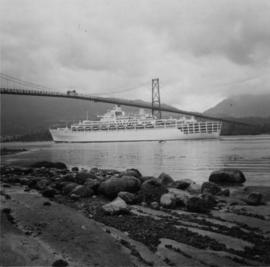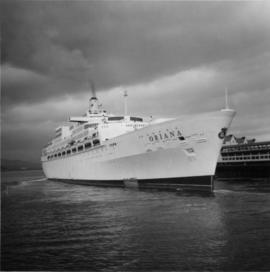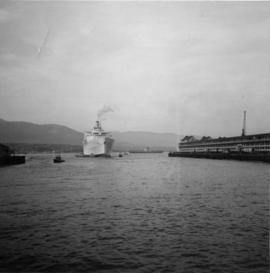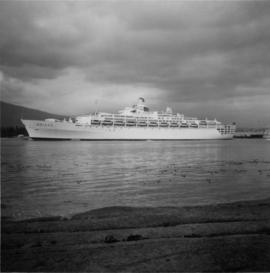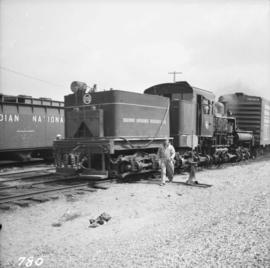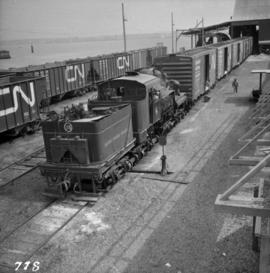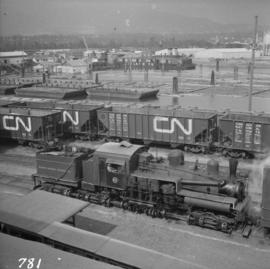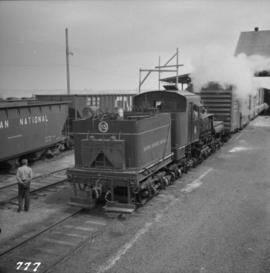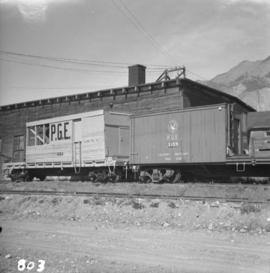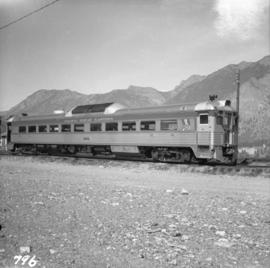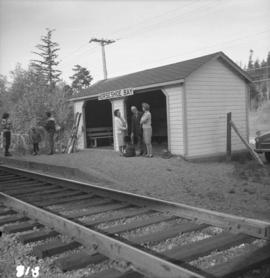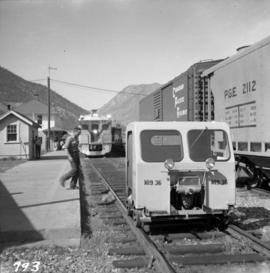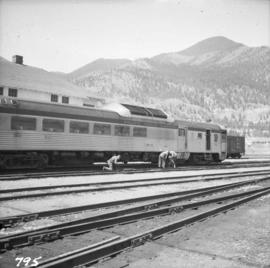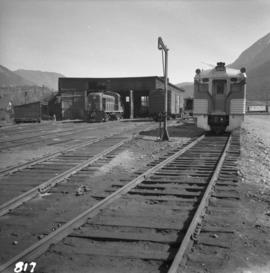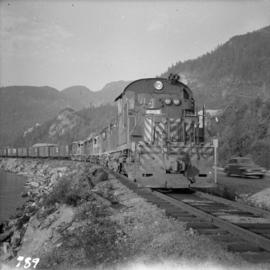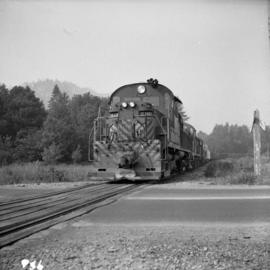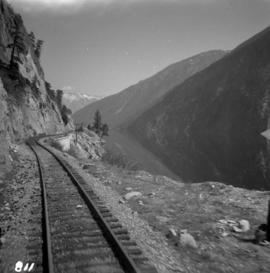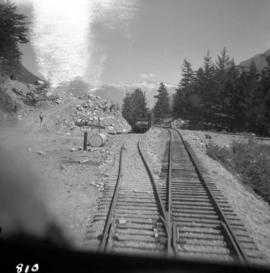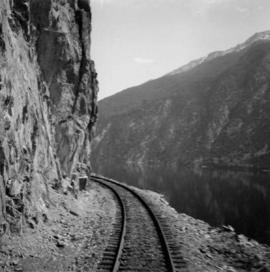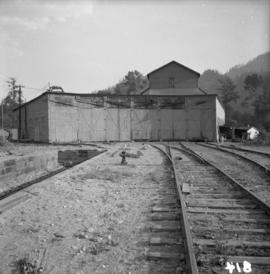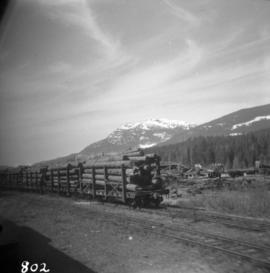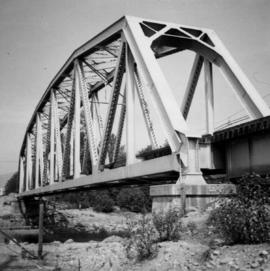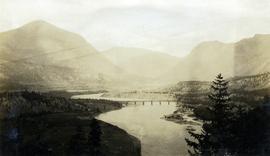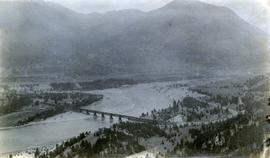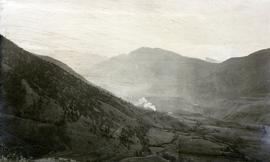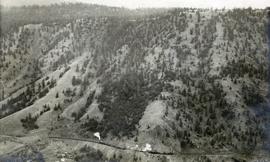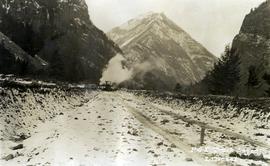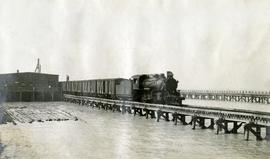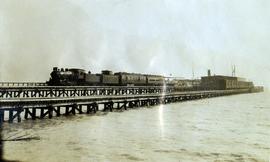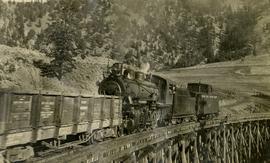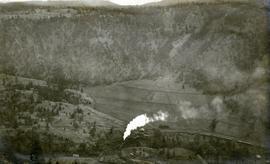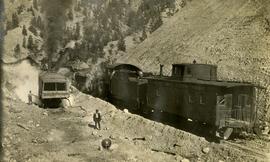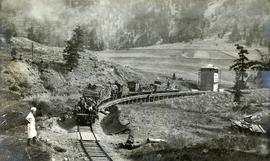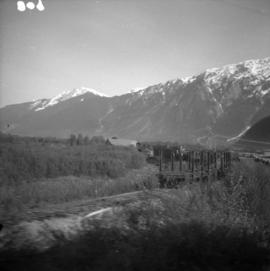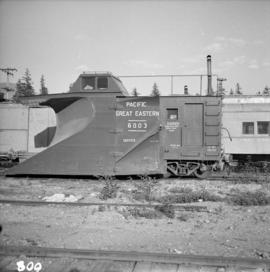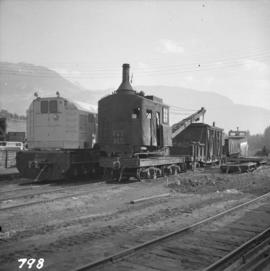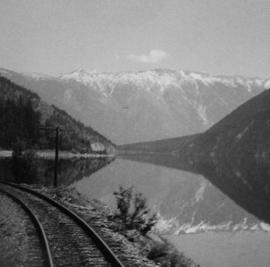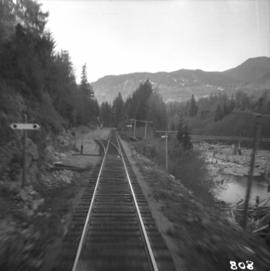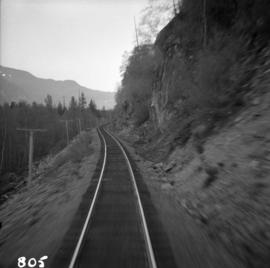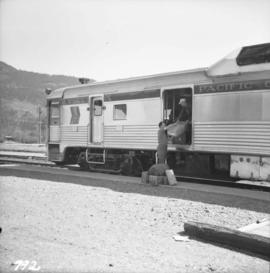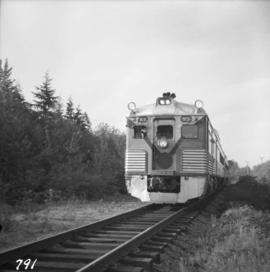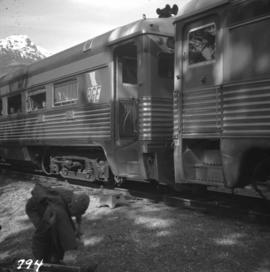Photograph depicts the Orient/P & O line, the "Oriana," that was built in 1960 by Vickes Armstrong. It was turbine driven.
Photograph depicts a P & O liner, the "Oriana," backing out from CPR Pier C in Vancouver. Minor assistance was needed from two cates tugs.
Photograph depicts a liner called the "Oriana."
Photograph depicts a P & O liner, the "Oriana," passing outward bound from Vancouver between Brockton Point and the Lion's Gate Bridge. Taken from Stanley Park.
Photograph depicts a P & O liner, the "Oriana," passing outward bound from Vancouver between Brockton Point and the Lion's Gate Bridge. Taken from Stanley Park.
Photograph depicts the Pacific Coast Terminals in North Vancouver. Shay locomotive #115 is in the yards.
Photograph depicts Pacific Coast Terminals in North Vancouver. A Shay #1115 is spotting cars carrying potash, sulphur etc. onto the tippler.
Photograph depicts the Pacific Coast Bulk Terminals on the North Shore, 1 mile east of Lions Gate Bridge in Vancouver. Previously owned by Hillcrest Lumber #11 and Merrill & Ring #5. In the foreground is 90-ton Shay locomotive #115 from the Railway Appliance Research Ltd. It was built by Lima Locomotive Works in 1929 and is builders #3350. It was last owned by Canadian Forest Products on Nimpkish Valley Railway on North Vancouver Island, up until at least the mid-1960s.
Photograph depicts the Pacific Coast Terminals in North Vancouver. A Shay #115 is spotting a string of cars onto tippler.
Photograph depicts the Pacific Great Eastern auxiliary tool cars at Lillooet.
Photograph depicts Pacific Great Eastern Budd car #10 at the Lillooet yards. It is in good condition, but not in service when the photograph was taken.
Photograph depicts that Pacific Great Eastern depot at Horseshoe Bay, awaiting the dayliner to Quesnel. A two-coach Budd car runs from North Vancouver to Lillooet, and then a different 1-coach Budd car continues to Quesnel. It is possible to do a roundtrip from North Vancouver to Lillooet in one day.
Photograph depicts the Pacific Great Eastern depot in Lillooet. The 4:05 pm train is about to depart for Vancouver, with a speeder leaving to check rock falls along Seton and Anderson lakes.
Photograph depicts the Pacific Great Eastern depot in Lillooet. In the photograph is the front coach #31 of a two-coach Budd car train, 5 minutes after arrival, being checked and serviced. On this day this two-coach unit left from North Vancouver at 8 am and arrived at Lillooet at 1:15 pm. It left Lillooet at 4:05 pm and returned to Vancouver at 9:30 pm. The total mileage run was 315 miles.
Photograph depicts a Pacific Great Eastern engine shed at Lillooet. At the right is Budd car #10 and at the left is an unidentified diesel.
Photograph depicts a southbound Pacific Great Eastern freight train on the south side of Britannia. It is headed by five locomotives.
Photograph depicts a southbound Pacific Great Eastern freight train with four locies, crossing the highway at Brackendale, near Squamish.
Photograph depicts the Pacific Great Eastern line beside Anderson Lake, west of Lillooet. The photograph was taken from the engineer's compartment of a Budd car unit/
Photograph depicts the Pacific Great Eastern line beside Anderson Lake. The temporary lumber spur was recently installed. The view is looking north.
Photograph depicts the Pacific Great Eastern line beside Anderson Lake. The photograph was taken from the engineer's compartment of a Budd car unit.
Photograph depicts the Pacific Great Eastern locomotive roundhouse at the Brackendale yards, north of Squamish. It was then used as a machine shop.
Photograph depicts Pacific Great Eastern log cars beside Green Lake, 35 miles north of Squamish.
Photograph depicts a Pacific Great Eastern rail bridge to crossing the Capilano River in west Vancouver. Photo is taken from the east shore looking west.
File consists of documentary photographs taken by David Davies of the Pacific Great Eastern Railway in British Columbia.
File consists of documentary photographs taken by David Davies of the Pacific Great Eastern (later BC Rail) main line of British Columbia.
File consists of documentary photographs taken by David Davies of the Pacific Great Eastern Railway in Seton Portage, British Columbia
Photograph depicts a view of the Pacific Great Eastern Railway bridge across the Fraser River at Lillooet.
Photograph depicts a view of the Pacific Great Eastern Railway bridge across the Fraser River and the nearby Lillooet surrounding area. The photograph shows Lillooet looking up Town Creek Valley. Chinese gold washing activity is visible nearby the bridge.
File consists of notes, clippings, and reproductions relating to the Pacific Great Eastern Railway line. Includes: "Remembering" special edition of the Coupler Marking the 75th anniversary of BC Rail and the PGE Railway (Jan. 1987). Also includes a photograph depicting the Ahbau railway bridge (2005).
Photograph depicts the Pacific Great Eastern Railway line at Pavilion looking south. An irrigation ditch line is also visible.
Photograph depicts a view of a train on the Pacific Great Eastern Railway line approximately 2 miles south of the Pavilion station.
File consists of notes, clippings, and reproductions relating to the original Pacific Great Eastern Railway line. Also includes photographs depicting various dirt roads (2001-2010).
This collection consists of photographs and "real photo" postcards that depict the construction and operation of the Pacific Great Eastern Railway line, communities nearby the railway line, and regional geography of areas adjacent to the PGE line.
File consists of documentary photographs taken by David Davies of the Pacific Great Eastern Railway Seton Portage Wreck in British Columbia.
Photograph depicts Pacific Great Eastern Railway track laying near Lillooet during railway construction. In the foreground, the railway grade along the south side of Cayoosh Creek about 1.5 miles before the junction with the Fraser River is depicted.
Photograph depicts a Pacific Great Eastern Railway train at the Squamish dock.
Photograph depicts a Pacific Great Eastern Railway train on the original dock at Squamish (Newport); the vessel in the distance behind the warehouse is quite likely the "MV Ballena", the subject of photograph 2020.08.01.
The equipment shown in this photograph is: Locomotive 51 or 52, built by Montreal Locomotive Works in 1913; caboose C-1, built by National Steel Car, Hamilton, Ontario in 1914; baggage-mail car 51 or 52; passenger coach 2, 3 or 4; and an unknown flat car outfitted as a sightseeing car with canopy. The time-frame for the photograph is between June 8, 1915 (when baggage-mail cars 51 & 52 arrived at Newport Dock) and some time in 1918 (when caboose C-1 was re-numbered to 1801).
Additional information on baggage-mail cars 51 & 52 and coaches 2, 3 & 4:
Baggage and mail cars 51 and 52 were purchased from E.H. Wilson & Co. of Philadelphia at a total cost of $2806.74 each. They were received on line June 4, 1915 and were barged to Newport on June 8. These cars had a length of 64 ft. over buffers, an inside length of 60 ft. and an inside width of 9 ft. 2½ in. and rode on 6-wheel trucks. Although not confirmed, these cars are believed to be of Pennsylvania Railroad heritage with PRR Class MM baggage and mail cars being the most likely candidates. Certainly, all the other cars purchased from E.H. Wilson & Co. were ex-Pennsylvania and the gasoline lighting system with which these cars were delivered was used extensively by the PRR.
Coaches 2, 3, & 4 are former Pennsylvania Railroad Class “PK” closed vestibule coaches #s 3077, 3080, & 3092 which were received on June 10, 1914 after being purchased from E.H. Wilson & Co. for $3859.11, $3858.87 & $3858.87 respectively. They were built by the PRR in 1905, 3070 and 3088 at Altoona Car Shops and 3092 at the Wilmington, Delaware shops of subsidiary Philadelphia, Baltimore and Washington. All had been assigned to P.B. & W. service. The Official Railway Equipment Register lists these cars as 62 ft. long with a capacity of 60 passengers.
Photograph depicts a Pacific Great Eastern Railway train on Pavilion Creek trestle at Mile 20.3. The train includes Locomotive #56, built by Canadian Locomotive Company of Kingston, Ontario, in August 1914, together with caboose C2, built by National Steel Car of Hamilton, Ontario in 1914 and a “Hart Convertible Car” #140 stencilled with indeterminable initials. These cars were convertible gondolas which were used as ballast cars with the ability to dump ballast either between or outside the rails depending on whether the centre floor doors or the side doors were opened. This particular car, which was scrapped in 1949, was part of a group of 15 cars remaining in number series 131 - 195 (not all numbers used) known on the PGE as “Red Harts” to distinguish them from a somewhat more modern version in number series 201 - 240 (again, not all numbers used) known as “Black Harts”.
The ca. 1921-1927 “PGE Bridge List” from the notebook of William H. Hewlett (1914-1968) references a 389.4 foot long, 34 ft. high, framed trestle with 26 spans of 14.8 feet at Mile 20.3 carrying the line over Pavilion Creek. There was a water tank at Pavilion located between the North end of the siding and the South end of the trestle. A track profile chart confirms that the track at this point is on a 12 degree curve.
"Canadian Railway and Marine World" reported in their January 1916 issue (p. 11, c.1), that track had been laid to within ½ mile of Clinton (Mile 45.0) on Dec. 14, 1915. If a constant rate of construction had been maintained from Mile 14, reached on July 30, 1915 as previously discussed, to Clinton, the approximate date of completion to Pavilion would be around the end of August, 1915 which is probably the earliest possible date for this photograph.
Photograph depicts a Pacific Great Eastern Railway train on Pavilion Creek trestle at Mile 20.3. Also visible are a water tank and possibly the graveyard at Pavilion.
The ca. 1921-1927 “PGE Bridge List” from the notebook of William H. Hewlett (1914-1968) references a 389.4 foot long, 34 ft. high, framed trestle with 26 spans of 14.8 feet at Mile 20.3 carrying the line over Pavilion Creek. There was a water tank at Pavilion located between the North end of the siding and the South end of the trestle. A track profile chart confirms that the track at this point is on a 12 degree curve. This photograph was taken from a vantage point up the hill to the North. The structures at the lower left of this image (2020.08.82) are consistent with a small construction camp, which accounts for the presence of a camp cook in image 2020.08.83.
"Canadian Railway and Marine World" reported in their January 1916 issue (p. 11, c.1), that track had been laid to within ½ mile of Clinton (Mile 45.0) on Dec. 14, 1915. If a constant rate of construction had been maintained from Mile 14, reached on July 30, 1915 as previously discussed, to Clinton, the approximate date of completion to Pavilion would be around the end of August, 1915 which is probably the earliest possible date for this photograph.
Photograph depicts a Pacific Great Eastern Railway locomotive, caboose (C2), and train cars operating as a work train, possibly on the south side of the Sallus Creek cut. A steam shovel may be loading gravel to or from the train cars. Location appears to be around the Lillooet area. The locomotive appears to be #56, a Canadian Locomotive Corporation 2-8-0, which was later lost in an Anderson Lake accident on August 8, 1944.
Photograph depicts a Pacific Great Eastern Railway work train on Pavilion Creek trestle at Mile 20.3. laden with workers, railway ties, and a steam donkey. The work train may be returning to a work camp, as a man dressed in the attire of a camp cook is standing beside the track.
The ca. 1921-1927 “PGE Bridge List” from the notebook of William H. Hewlett (1914-1968) references a 389.4 foot long, 34 ft. high, framed trestle with 26 spans of 14.8 feet at Mile 20.3 carrying the line over Pavilion Creek. There was a water tank at Pavilion located between the North end of the siding and the South end of the trestle. A track profile chart confirms that the track at this point is on a 12 degree curve. This photograph was taken at trackside. The structures at the lower left of image 2020.08.82 are consistent with a small construction camp, which accounts for the presence of a camp cook in this image (2020.08.83).
"Canadian Railway and Marine World" reported in their January 1916 issue (p. 11, c.1), that track had been laid to within ½ mile of Clinton (Mile 45.0) on Dec. 14, 1915. If a constant rate of construction had been maintained from Mile 14, reached on July 30, 1915 as previously discussed, to Clinton, the approximate date of completion to Pavilion would be around the end of August, 1915 which is probably the earliest possible date for this photograph.
Photograph depicts the Pacific Great Eastern siding at Pemberton on the east and north side of the depot, leading to the pole yard.
Photograph depicts a Pacific Great Eastern snowplow at the Brackendale yards near Squamish.
Photograph depicts a Pacific Great Eastern steam yard crane at Brackendale yards, north of Squamish. The mainline wrecking crane is alongside. The crane was built in 1913 by Industrial Work, Oak Bay, Michigan, U.S.A.
Photograph depicts the Pacific Great Eastern track looking northeast along Seton or Anderson Lake.
Photograph depicts the Pacific Great Eastern track at about Mile 70 from Vancouver. In the vicinity of Jordans and Brandy Wine Falls. The photograph was taken from the engineer's cab of a Budd car and depicts a view looking south.
Photograph depicts the Pacific Great Eastern track at about Mile 70, in the vicinity of Jordans and Brandy Wine Falls. The photograph was taken from the cab of a Budd car and has a view looking south.
Photograph depicts a Pacific Great Eastern two car Budd unit at Pemberton. It is unloading baggage. It arrived at 11:10 am and is travelling north.
Photograph depicts the Pacific Great Eastern northbound daily two-coach Budd car unit approaching Horseshoe Bay depot. Car #31 is leading.
Photograph depicts a Pacific Great Eastern two-coach Budd car unit on its daily run travelling north to Lillooet. It is stopped at Garibaldi Station to put down skiers. It is on a very tight schedule, giving it less than 60 seconds halt. At the right is the front car #31.
